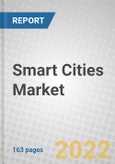Report Scope
The report provides an overview of the global smart city market and analyzes market trends. Using 2021 as the base year, the report provides estimated market data for 2022 through 2027. Revenue forecasts for this period are segmented based on technology type, application and region. The report also focuses on the major driving trends and challenges that affect the market. The report concludes with detailed profiles of the major global smart city market players
Report Includes
- 41 data tables and 39 additional tables
- An up-to-date overview of the global market for smart city technologies
- Analyses of the global market trends, with data from 2021, estimates for 2022, 2023, and 2025, and projections of compound annual growth rates (CAGRs) through 2027
- Highlights of the upcoming market potential for global smart cities market, and areas of focus to forecast this market into various segments and subsegments
- Evaluation and forecast the market size for smart cities, projected growth trends, and corresponding market share analysis technology type, application area, and geographic region
- Discussion of current market scenario for smart city technologies, industry value chain analysis, and the future direction of this market
- Technology assessment of the key drivers, restraints and opportunities that will shape the market for smart cities growing new IT markets over the forecast period (2021 to 2027)
- Updated information on key mergers and acquisitions, agreements, partnerships, collaborations, product innovations, and other major market expansion strategies adopted by key players in the global smart cities market
- Insight into the ongoing research activities, key technology issues, industry-specific challenges, major types of end-user markets, and COVID-19 impact on the smart cities growing new IT market
- Descriptive company profiles of the leading global players, including Accenture PLC, Ericsson, Hitachi, Microsoft Corp., Nokia and Schneider Electric
Table of Contents
Chapter 1 Introduction
Chapter 3 Market and Technology Background
Chapter 4 Market Breakdown by Technology Type
Chapter 5 Market Breakdown by Application
Chapter 6 Market Breakdown by Region
Chapter 7 Market Opportunities
Chapter 8 Company Profiles
List of Tables
List of Figures
Executive Summary
A “smart city” is an innovative urban center that uses information and communication technologies (ICT) to improve the quality of life, urban operations and services to meet the needs of present and future generations for economic, social and environmental aspects. It uses the ICT intelligent network with connected devices and machines for data transfer through the cloud and wireless technology. Smart cities use smart IoT solutions to enhance the existing infrastructure and to help the government manage its services, such as municipalities, public transportation, water and waste management, and energy retail. The sensors, cameras and networks provide real-time information on the city’s traffic status,energy consumption, pollution level and water usage.
Smart city technologies to help solve the challenges of global urbanization, urban migration trends, environmental degradation, climate change, aging populations and infrastructures to optimize resource utilization. The increasing population shift toward urbanization involves the demand and supply balance of connected transport facilities, employment, healthcare facilities, air quality, education and electricity. Smart cities use automated, networked and intelligent technology systems that ensure the quality of life for all by providing smart homes, connected vehicles, smart healthcare, traffic management, energyefficient transportation and buildings. Smart cities help to fight against the significant issues of urbanization, such as air quality, mobility, energy, and safety and security.
The COVID-19 pandemic further enhanced the need for smart cities, as the pandemic has tested the health infrastructure and the social and economic conditions of cities across the globe. Smart cities helped to fight against the pandemic with real-time monitoring of COVID guidelines, lockdowns, proper vaccination drives and remote healthcare facilities. The importance of a smart city was highlighted in difficult times, as it relies on the concept of technology use for citizen well-being. With accelerated urbanization, global cities have transformed into massive cosmopolitan regions with considerable cultural diversity. Smart cities guarantee a sustainable infrastructure without upsetting the ecological
balance and provide improved residential and commercial centers that offer rational, advanced and more innovative lifestyles for the future.
A smart city collects data on a real-time basis with the help of sensors and cameras. Once the data are collected, they are studied and analyzed to acquire information regarding a city’s various operations and services. After data analysis, the outcome is communicated to the concerned person to assist in better and timely action. The last step in working the smart city is the action taken based on the real-time data received and analyzed. The final action is taken to improve the existing operation or as a precautionary measure to avoid potential damage or loss.
Companies Mentioned
- Accenture plc
- At&T
- Cisco Systems Inc.
- Ericsson
- Fujitsu
- Hitachi
- Huawei Technologies Co. Ltd.
- Ibm Corp.
- Intel Corp.
- Microsoft Corp.
- Nokia
- Oracle Corp.
- Sap
- Schneider Electric
- Siemens
- Other Smart City Companies
- Abb Tropos
- Arup
- Atos Se
- Autodesk Inc.
- Capgemini
- Cityzenith
- Esri
- General Electric
- Hewlett-Packard
- Itron
- Orange Group
- Sensus
- Telefonica
- Toshiba
- Trilliant
- Urbiotica
- Veolia
- Verizon Communications
- Vodafone
- Institutions
- C40 Cities Initiative
- European Investment Bank
- European Commission
- International Energy Agency (Iea)
- Intergovernmental Panel on Climate Change (Ipcc)
Table Information
| Report Attribute | Details |
|---|---|
| No. of Pages | 163 |
| Published | June 2022 |
| Forecast Period | 2022 - 2027 |
| Estimated Market Value ( USD | $ 1 Trillion |
| Forecasted Market Value ( USD | $ 2.8 Trillion |
| Compound Annual Growth Rate | 22.6% |
| Regions Covered | Global |
| No. of Companies Mentioned | 41 |









